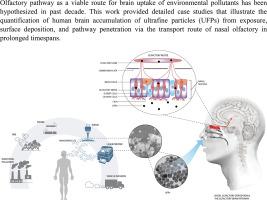NanoImpact ( IF 4.7 ) Pub Date : 2021-05-04 , DOI: 10.1016/j.impact.2021.100322 Yidan Shang 1 , Rui Chen 2 , Ru Bai 3 , Jiyuan Tu 4 , Lin Tian 5

|
Olfactory pathway as a viable route for brain uptake of environmental pollutants has been hypothesized in past decade. In such a hypothesis, subclinical low-dose exposure and chronic brain accumulation of exogenous airborne agents are critical to define neurodegenerations, however the information is extremely lacking. Advances in granular measurement of air pollutants, real-time personal exposure monitoring and big data analytics have opened-up an unprecedented opportunity to enable researchers conduct longitudinal investigation and potentially link the external environment condition to risks of human developing neurodegenerative diseases in a foreseeable future. Detailed case studies are provided in this work that illustrate the quantification of human brain accumulation of ultrafine particles (UFPs) from exposure, surface deposition, and pathway penetration via the transport route of nasal olfactory in prolonged timespans. The study links the individual components along the olfactory pathway, showcases the available research capacity, and pinpoints the critical areas of research need in environmental, toxicological and epidemiological studies, significant to a joint effort to bring together an interdisciplinary solution to uncover the insight of time course and dose dependency between environmental exposure and risk of developing neurodegenerative diseases in a foreseeable future. It should be noted that current study assumes that nanoparticle penetration along the olfactory pathway is unidirectional and follows the rate observed in the rodent study. Tissue responses in determining the penetration and retention corresponding to size and composition of the inhaled nanoparticles are not considered.
中文翻译:

量化由于环境排放而通过人类嗅脑通路吸入的超细颗粒的长期积累——一项初步研究
在过去的十年中,人们假设嗅觉通路是大脑吸收环境污染物的可行途径。在这样的假设中,亚临床低剂量暴露和外源性空气传播因子的慢性脑积聚对于定义神经退行性变至关重要,但信息极为缺乏。空气污染物颗粒测量、实时个人暴露监测和大数据分析的进步为研究人员提供了前所未有的机会,使研究人员能够进行纵向调查,并可能在可预见的未来将外部环境条件与人类患神经退行性疾病的风险联系起来。这项工作提供了详细的案例研究,说明了暴露、表面沉积、以及通过鼻嗅觉传输路径在较长时间跨度内的通路渗透。该研究将嗅觉通路中的各个组成部分联系起来,展示了可用的研究能力,并指出了环境、毒理学和流行病学研究中研究需求的关键领域,这对于共同努力汇集跨学科解决方案以揭示时间洞察力具有重要意义在可预见的未来,环境暴露与发生神经退行性疾病的风险之间的过程和剂量依赖性。应该注意的是,目前的研究假设纳米粒子沿嗅觉通路的渗透是单向的,并且遵循啮齿动物研究中观察到的速率。











































 京公网安备 11010802027423号
京公网安备 11010802027423号